
A berry is a small, pulpy, and often edible fruit. Typically, berries are juicy, rounded, brightly colored, sweet, sour or tart, and do not have a stone or pit, although many pips or seeds may be present. Common examples are strawberries, raspberries, blueberries, blackberries, red currants, white currants and blackcurrants. In Britain, soft fruit is a horticultural term for such fruits.

Biological control or biocontrol is a method of controlling pests, whether pest animals such as insects and mites, weeds, or pathogens affecting animals or plants by using other organisms. It relies on predation, parasitism, herbivory, or other natural mechanisms, but typically also involves an active human management role. It can be an important component of integrated pest management (IPM) programs.
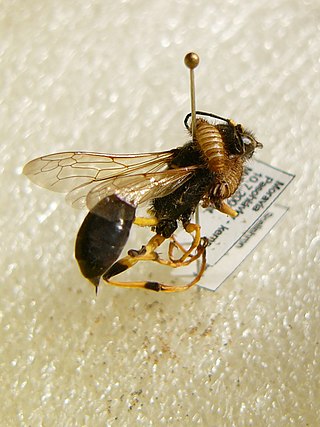
A pest is any animal or plant harmful to humans or human concerns. The term is particularly used for creatures that damage crops, livestock, and forestry or cause a nuisance to people, especially in their homes. Humans have modified the environment for their own purposes and are intolerant of other creatures occupying the same space when their activities impact adversely on human objectives. Thus, an elephant is unobjectionable in its natural habitat but a pest when it tramples crops.
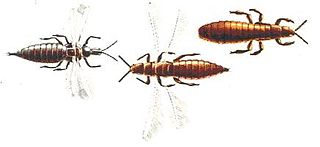
Thrips are minute, slender insects with fringed wings and unique asymmetrical mouthparts. Entomologists have described approximately 6,000 species. They fly only weakly and their feathery wings are unsuitable for conventional flight; instead, thrips exploit an unusual mechanism, clap and fling, to create lift using an unsteady circulation pattern with transient vortices near the wings.
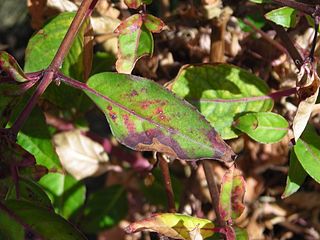
Impatiens necrotic spot orthotospovirus(INSV) is a plant pathogenic virus of the order Bunyavirales. It was originally believed to be another strain of Tomato spotted wilt virus, but genetic investigations revealed them to be separate viruses. It is a negative-strand RNA virus which has a tripartite genome. It is largely spread by the insect vector of the western flower thrips. The virus infects more than 648 species of plants including important horticultural and agricultural species such as fuchsia, tomato, orchids, and lettuce (especially romaine). As the name implies, the main symptom on plants is necrotic spots that appear on the leaves. The INSV virus infects by injecting the RNA the virus contains into the cell which then starts using the cell resources to transcribe what the virus RNA states. Viral infection can often result in the death of the plant. The disease is mainly controlled by the elimination of the western flower thrip vector and by destroying any infected plant material.
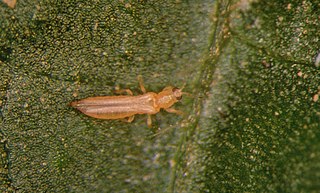
The western flower thrips [Frankliniella occidentalis (Pergande)] is an invasive pest insect in agriculture. This species of thrips is native to the Southwestern United States but has spread to other continents, including Europe, Australia, and South America via transport of infested plant material.

Orthotospovirus is a genus of negative-strand RNA viruses, in the family Tospoviridae of the order Bunyavirales, which infects plants. Tospoviruses take their name from the species Tomato spotted wilt orthotospovirus (TSWV) which was discovered in Australia in 1919. TSWV remained the only known member of the family until the early 1990s when genetic characterisation of plant viruses became more common. There are now at least twenty species in the genus with more being discovered on a regular basis. Member viruses infect over eight hundred plant species from 82 different families.
Strawberry foliar nematode, or strawberry crimp nematode, is a disease caused by Aphelenchoides fragariae, a plant pathogenic nematode. It is common in strawberries and ornamental plants and can greatly affect plant yield and appearance, resulting in a loss of millions of dollars of revenue. Symptoms used to diagnose the disease are angular, water soaked lesions and necrotic blotches. Aphelenchoides fragariae is the nematode pathogen that causes the disease. Its biological cycle includes four life stages, three of which are juvenile. The nematode can undergo multiple life cycles in one growing season when favorable conditions are present. The crowns, runners, foliage, and new buds of the plant via stylet penetration or through the stomata can be infected. The best management practices for this disease are sanitation, prevention of induction of the pathogen to the environment, and planting clean seed or starter plants.

The chilli thrips or yellow tea thrips, Scirtothrips dorsalis Hood, is an extremely successful invasive species of pest-thrips which has expanded rapidly from Asia over the last twenty years, and is gradually achieving a global distribution. It has most recently been reported in St. Vincent (2004) Florida (2005), Texas (2006), and Puerto Rico (2007). It is a pest of economic significance with a broad host range, with prominent pest reports on crops including pepper, eggplant, mango, citrus, strawberry, grapes, cotton, tea, peanuts, blueberry, and roses. Chilli thrips appear to feed preferentially on new growth, and infested plants usually develop characteristic wrinkled leaves, with distinctive brown scarring along the veins of leaves, the buds of flowers, and the calyx of fruit. Feeding damage can reduce the sale value of crops produced, and in sufficient numbers, kill plants already aggravated by environmental stress. This thrips has also been implicated in the transmission of three tospoviruses, but there is some controversy over its efficiency as a vector.
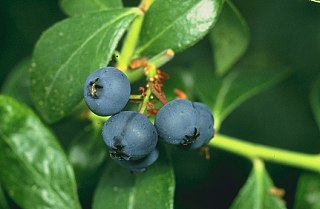
Blueberries are a widely distributed and widespread group of perennial flowering plants with blue or purple berries. They are classified in the section Cyanococcus within the genus Vaccinium. Vaccinium also includes cranberries, bilberries, huckleberries and Madeira blueberries. Commercial blueberries—both wild (lowbush) and cultivated (highbush)—are all native to North America. The highbush varieties were introduced into Europe during the 1930s.
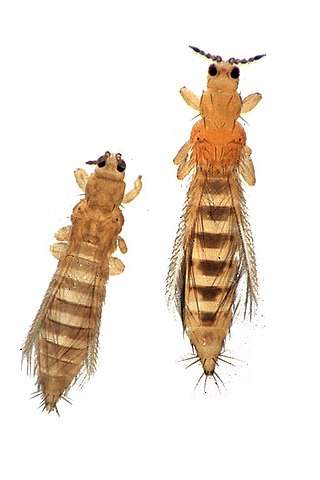
The Thripinae are a subfamily of thrips, insects of the order Thysanoptera. The Thripinae belong to the common thrips family Thripidae and include around 1,400 species in 150 genera. A 2012 molecular phylogeny found that the Thripinae was paraphyletic; further work will be needed to clarify the relationships within the group.

Neoseiulus cucumeris, the cucumeris mite, is a species of predatory mite in the family Phytoseiidae. It is used in biological pest control of western flower thrips in cucumber and some other greenhouse crops.
Dicyphus hesperus is a species of true bug in the family Miridae. It is a generalist predator of other insects and also feeds on plant tissues. It is native to North America and has been used there in biological control of agricultural pests, especially whitefly on tomatoes.
Typhlodromips swirskii, the Swirski mite, is a species of predatory mite in the family Phytoseiidae. It is used in biological pest control of western flower thrips in greenhouse or indoor grown crops.
Frankliniella schultzei, the common blossom thrips or cotton thrips, is a species of thrips in the family Thripidae. It is found in many parts of the world and is an important pest insect in agriculture.
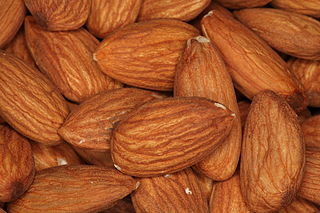
Agriculture is a significant sector in California's economy, producing nearly US$50 billion in revenue in 2018. There are more than 400 commodity crops grown across California, including a significant portion of all fruits, vegetables, and nuts for the United States. In 2017, there were 77,100 unique farms and ranches in the state, operating across 25.3 million acres of land. The average farm size was 328 acres (133 ha), significantly less than the average farm size in the U.S. of 444 acres (180 ha).
Heliothrips haemorrhoidalis is a species of thrips in the family Thripidae. It is most commonly known as the greenhouse thrips, the glasshouse thrip or black tea thrips. This species of thrips was first described in 1833 by Bouché in Berlin, Germany. H. haemorrhoidalis also has many synonyms depending on where they were described from such as: H. adonidum Haliday, H. semiaureus Girault, H. abdominalis Reuter, H. angustior Priesner, H. ceylonicus Schultz, Dinurothrips rufiventris Girault. In New Zealand, H. haemorrhoidalis is one of the four species belonging to the subfamily Panchaetothripinae.

California is the largest grower of peaches in the United States, producing about 70% of the total.













